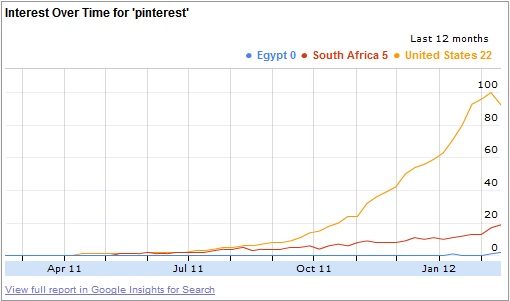Few Africans use Pinterest outside of South Africa (for now)
Could Pinterest, a visual social network, eventually solve the challenge of bringing illiterate African online?
Pinterest is the Internet’s new darling, hands-down. The ultra-visual site allows users to create scrapbooks (“pinboards”) of images they find from across the Internet. Think of it as reddit meets Flickr. Not only is the site organizational, but it is also quite social (and inspirational). Despite Pinterest’s rapid ascent in web traffic this year in the United States – it had 1/3 the number of visits as Twitter in January 2012 – few Africans are using the site. Much of the reason is that the average African Internet user does not fall withing the target demographic of Pinterest. Just as importantly, Pinterest demands more than a 2G or slow 3G Internet connection.
Evidence suggests the site is slowly taking hold in African nations furthest along the Internet timeline:

South Africans have searched for 'Pinterest' more than ever since October 2011. Egyptian Googlers have just crossed the data threshold. Still, the share of SA/EG search volume pales in comparison with the United States. {Google}
Google Insights for Search shows that South African search volume for Pinterest has steadily increased since late-2011. Enough Egyptians are now searching for the site to warrant data inclusion. However, no other African nations produced the search volume needed to be properly tracked by Google. Interestingly, South Africa and Egypt have had Internet access longer than all African nations except Tunisia.
The information company Alexa ranks Pinterest as the 55th most popular website visited by South Africans over the past 3 months. In fact, the South African blog Seoblog.co.za recently published an article explaining Pinterest. ConnectedAfrica (based in Accra, Ghana) shared a similar explanation just two weeks ago. Finally, just days ago, Loy Okezie spotted an image of the Nigerian Honourable Minister of Information and Communication.
Why Pinterest is not suited for African users:
- Demographic: The typical Pinterest user is female and is over the age of 25. The typical African web user is still predominantly young and male. Plus, users tend to be ordinary people and not the early adopters/early majority who are currently accessing the Internet in many African locales.
- Bandwidth: Pinterest requires more bandwidth than Facebook or Twitter to operate. The Pinterest homepage is 2.2 megabytes in size. Large images take some time to load on slow connections. A good 3G or Wi-Fi connection is a must.
- Mobile user experience: The process of pinning photos via mobile is cumbersome. And, the iPhone app doesn’t allow for pinning – just for browsing and re-pinning. Plus, part of the fun is viewing boards on a large monitor – not a single photo at a time.
- Barrier to content creation: The spirit of Pinterest thrives upon vibrant images. These are not your grainy, run-of-the-mill photos. Most pins are of high resolution photographs taken with SLR cameras – not mobile devices. (However, there is nothing wrong with a user who simply shares the content of others.)
- Brand marketing: Brands are starting to use the site to promote their products. E-commerce is still in its early stages in most African nations (apart from South Africa), so don’t expect a brand’s presence on the site to attract new users to Pinterest.
- Limited real benefits: Pinterest does not serve health, governance, agricultural, or schooling needs. Those using mobile devices to simply survive may not have time or the desire to browse home decorating ideas or travel photos, for example.
That said, Pinterest has certain features that could aid its adoption in Africa:
- Minimal literacy requirement: The only words on the site are titles and brief captions or comments. A pin requires less text that the typical SMS (and certainly fewer characters than a Tweet).
- Mobile-friendly (assuming adequate bandwidth): Images load one-at-a-time when viewed by mobile. The site actually displays well on recent Android devices. And, there is an available iPhone/iPad app.
- Integration with Facebook: Why not create another social media account if it can be integrated with the most popular network on the planet?
We won’t go so far as to predict Pinterest will drive Internet adoption in Africa. After all, the technical constraints are just too great at this time. Still, the social network has great potential due to its visual nature. Definitely worth monitoring this year.












 Twitter
Twitter Facebook
Facebook Pinterest
Pinterest
Nice article, if decent bandwidth was available it could be a new ball game.
Agreed. Thinking for now that online noticeboards easily accessible via mobile will take hold. Like the new start-up Mimiboard.
With clipam.com now available,…who needs pinterest in Africa
[…] like more purposeful art. Pinterest is great for sharing photos, but few photos taken by Africans seem to exist on the network. However, it turns out that quite a few African artists are pushing the digital […]
[…] OAfrica.com addressed a few reasons as to why Pinterest was not suited for African users outside of South Africa due to some factors. Although those factors didn’t directly affect South African users the reasons were valid. With South Africans moving forward in technology use, Nando’s have managed to utilize Pinterest in the South African market with an unrivaled campaign that we hope will drive more South Africans to use Pinterest. We’re also hoping to see more retailers use the platform for their next campaign. Pinterest is an untapped resource in South African advertising and Nando’s have opened the door. […]